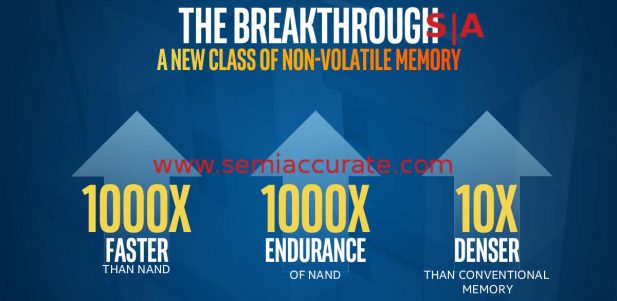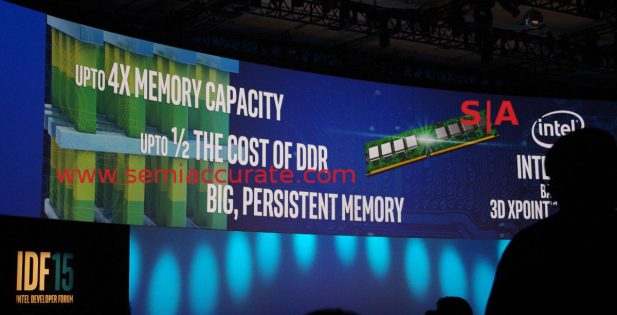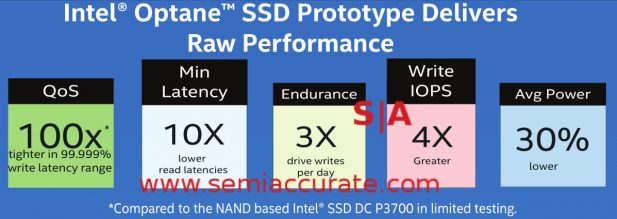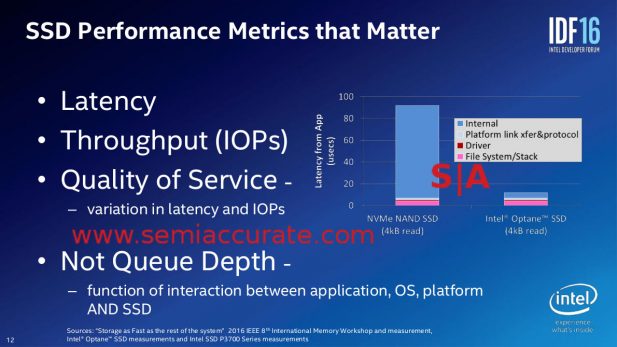 Intel’s Xpoint/Optane NVRAM may be ‘shipping’ but at the moment it is simply broken. SemiAccurate hasn’t seen this many orders of magnitude of public backpedaling in a long time.
Intel’s Xpoint/Optane NVRAM may be ‘shipping’ but at the moment it is simply broken. SemiAccurate hasn’t seen this many orders of magnitude of public backpedaling in a long time.
Lets start out with the good news, we really think that Intel and Micron’s Xpoint memory is a game changing technology, or would be if it worked. We exclusively told you about the DIMM version months before it was public, it is what is now referred to as Apache Pass vs the SSD version called Coldstream. The latter one works, sort of.
That brings us to today’s tale of woe, Intel’s version of Xpoint and its lack of functionality. Please do note that while Micron was at the joint coming out party, they have not announced any products so, well, they are meeting their deliverables so far. Intel on the other hand has a different story to tell. Lets start out with their statements from launch on July 28, 2015. Do pay attention to the numbers, they will matter later, starting with this slide from the launch.

Promised specs look really good
OK, 1000x faster than NAND, 1000x the endurance of NAND, and 10x denser than conventional memory. All spectacular, game changing numbers, professed to by the Intel engineers, executives, and PR folk multiple times. Great stuff. Step forward a mere few weeks to IDF 2015 and the keynote presentations.

4x is really close to 10x, right
Hmmm, 10x the density just became 4x the density, not good but that 4x number is backed up by multiple presentations SemiAccurate has seen from IDF2015 to weeks ago. This covers both public and NDA documents, all now stick to a number that is not 10x the density. No doubt Intel will have a PR approved and very plausible sounding reason for the differences but SemiAccurate’s sources say the NDA version reflects a large climb down on the density promise. That’s not good but a livable result, right?

These are the 2016 claims from Intel
It would be if the numbers on the above slide from IDF2016 weren’t there. Latency claims seem to have decreased a bit here and there, do notice that the claimed 1000x faster is now ummm, 10x faster, a mere 100x difference. What is two orders of magnitude between friends? Before you wonder if this is a misstatement or an apples to airliners comparison, the following slide from another IDF2016 presentation unquestionably backs up the claim. The second 10x claim, not the 1000x original one. It also confirms a two orders of magnitude backpedaling by Intel. 100x, hard to get worse than that, right?

Data does not say 1000x, closer to 10x I think
Actually if you are Intel, it is easy enough to top a 100x backpedaling if you are talking about broken technologies like Xpoint/Optane. Take a look at the endurance numbers in the launch slide, that would be another 1000x claim, and in the IDF2016 slide, that would be a 3x claim, both vs NAND so direct apples to apples comparisons, no wonder Apple isn’t going to use this. In case you are wondering, 3 goes into 1000 333 times.
Back to the serious side of things, we have three direct claims by Intel about their upcoming NVRAM technology called Xpoint. They claimed 10x the density of DRAM, it is now 4x or a 2.5x decrease. That is a stunning deliverable but sadly it is the best performance of any of their claims. Latency missed by 100x, yes one hundred times, on their claim of 1000x faster, 10x is now promised and backed up by tests. More troubling is endurance, probably the main selling point of this technology over NAND. Again the claim was a 1000x improvement, Intel delivered 1/333rd of that with 3x the endurance.
All of these examples and more are found in multiple Intel public documents from the last IDF to joint presentations with partners, and many more too. All back up the slides presented here with the same stunning decreases. If you think the public version with 100x/333x decreases is enough to warrant our claim of ‘broken’, wait until you hear what they are telling people behind closed doors. SemiAccurate has talked to multiple sources over the past few months, all of which heard the same story from Intel. And yes it gets worse.
Note: The following is for professional and student level subscribers.
Disclosures: Charlie Demerjian and Stone Arch Networking Services, Inc. have no consulting relationships, investment relationships, or hold any investment positions with any of the companies mentioned in this report.
Note: The following is analysis for professional level subscribers only.
Charlie Demerjian
Latest posts by Charlie Demerjian (see all)
- Qualcomm Is Cheating On Their Snapdragon X Elite/Pro Benchmarks - Apr 24, 2024
- What is Qualcomm’s Purwa/X Pro SoC? - Apr 19, 2024
- Intel Announces their NXE: 5000 High NA EUV Tool - Apr 18, 2024
- AMD outs MI300 plans… sort of - Apr 11, 2024
- Qualcomm is planning a lot of Nuvia/X-Elite announcements - Mar 25, 2024